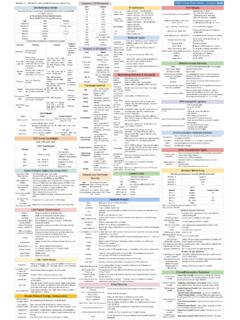Transcription of Network Security - Tutorialspoint
1 Network Security i About the Tutorial Network Security deals with all aspects related to the protection of the sensitive information assets existing on the Network . It covers various mechanisms developed to provide fundamental Security services for data communication. This tutorial introduces you to several types of Network vulnerabilities and attacks followed by the description of Security measures employed against them. It describes the functioning of most common Security protocols employed at different networking layers right from application to data link layer. After going through this tutorial, you will find yourself at an intermediate level of knowledge regarding Network Security .
2 Audience This tutorial is prepared for beginners to help them understand the basics of Network Security . The ones who are keen on taking up career in the field of Information and Network Security , this tutorial is extremely useful. For all other readers, this tutorial is a good learning material. Prerequisites We assume the reader has a basic understanding of computer networking and cryptography. Knowledge about communication protocols is a plus. Disclaimer & Copyright Copyright 2018 by Tutorials Point (I) Pvt. Ltd. All the content and graphics published in this e-book are the property of Tutorials Point (I) Pvt. Ltd. The user of this e-book is prohibited to reuse, retain, copy, distribute or republish any contents or a part of contents of this e-book in any manner without written consent of the publisher.
3 We strive to update the contents of our website and tutorials as timely and as precisely as possible, however, the contents may contain inaccuracies or errors. Tutorials Point (I) Pvt. Ltd. provides no guarantee regarding the accuracy, timeliness or completeness of our website or its contents including this tutorial. If you discover any errors on our website or in this tutorial, please notify us at Network Security ii Table of Contents About the Tutorial .. i Audience .. i Prerequisites .. i Disclaimer & Copyright .. i Table of Contents .. ii 1. Network Security OVERVIEW .. 1 physical Network .. 1 Network Protocol .. 2 Goals of Network Security .. 6 Achieving Network Security .. 6 2.
4 Network Security APPLICATION LAYER Security .. 8 E-mail Security .. 8 PGP .. 13 S / MIME .. 15 DNS Security .. 16 Summary .. 18 3. Network Security Security IN TRANSPORT LAYER .. 19 Need for Transport Layer Security .. 19 Secure Socket Layer (SSL) .. 20 TLS Protocol .. 27 Secure Browsing - HTTPS .. 28 Secure Shell Protocol (SSH) .. 30 Benefits & Limitations .. 32 Summary .. 32 Network Security iii 4. Network Security Network LAYER Security .. 34 Security in Network Layer .. 34 Overview of IPsec .. 36 IPsec Communication Modes .. 37 IPsec Protocols .. 40 Security Associations in IPsec .. 44 Summary .. 47 5. Network Security DATA link LAYER Security .. 48 Security Concerns in Data link Layer.
5 48 Securing Ethernet LANs .. 50 Securing Spanning Tree Protocol .. 52 Securing Virtual 53 Securing Wireless LAN .. 55 Summary .. 57 6. Network Security Network ACCESS CONTROL .. 58 Securing Access to Network Devices .. 58 User Authentication and Authorization .. 58 Password Based Authentication .. 59 Centralized Authentication Methods .. 59 Access Control Lists .. 60 7. Network Security FIREWALLS .. 61 Types of Firewall .. 61 Stateless & Stateful Packet Filtering Firewall .. 62 Application Gateways .. 63 Circuit-Level Gateway .. 65 Network Security iv Firewall Deployment with DMZ .. 65 Intrusion Detection / Prevention System .. 67 Types of IDS .. 68 Summary .. 69 8. Network Security CRITICAL NECESSITY.
6 70 Role of Network in Business .. 70 Necessity for Network Security .. 71 Network Security 1 In this modern era, organizations greatly rely on computer networks to share information throughout the organization in an efficient and productive manner. Organizational computer networks are now becoming large and ubiquitous. Assuming that each staff member has a dedicated workstation, a large scale company would have few thousands workstations and many server on the Network . It is likely that these workstations may not be centrally managed, nor would they have perimeter protection. They may have a variety of operating systems, hardware, software, and protocols, with different level of cyber awareness among users.
7 Now imagine, these thousands of workstations on company Network are directly connected to the Internet. This sort of unsecured Network becomes a target for an attack which holds valuable information and displays vulnerabilities. In this chapter, we describe the major vulnerabilities of the Network and significance of Network Security . In subsequent chapters, we will discuss the methods to achieve the same. physical Network A Network is defined as two or more computing devices connected together for sharing resources efficiently. Further, connecting two or more networks together is known as internetworking. Thus, the Internet is just an internetwork a collection of interconnected networks.
8 For setting up its internal Network , an organization has various options. It can use a wired Network or a wireless Network to connect all workstations. Nowadays, organizations are mostly using a combination of both wired and wireless networks. Wired & Wireless Networks In a wired Network , devices are connected to each other using cables. Typically, wired networks are based on Ethernet protocol where devices are connected using the Unshielded Twisted Pair (UTP) cables to the different switches. These switches are further connected to the Network router for accessing the Internet. In wireless Network , the device is connected to an access point through radio transmissions. The access points are further connected through cables to switch/router for external Network access.
9 1. Network Security Overview Network Security 2 Wireless networks have gained popularity due to the mobility offered by them. Mobile devices need not be tied to a cable and can roam freely within the wireless Network range. This ensures efficient information sharing and boosts productivity. Vulnerabilities & Attacks The common vulnerability that exists in both wired and wireless networks is an unauthorized access to a Network . An attacker can connect his device to a Network though unsecure hub/switch port. In this regard, wireless Network are considered less secure than wired Network , because wireless Network can be easily accessed without any physical connection.
10 After accessing, an attacker can exploit this vulnerability to launch attacks such as: Sniffing the packet data to steal valuable information. Denial of service to legitimate users on a Network by flooding the Network medium with spurious packets. Spoofing physical identities (MAC) of legitimate hosts and then stealing data or further launching a man-in-the-middle attack. Network Protocol Network Protocol is a set of rules that govern communications between devices connected on a Network . They include mechanisms for making connections, as well as formatting rules for data packaging for messages sent and received. Network Security 3 Several computer Network protocols have been developed each designed for specific purposes.











